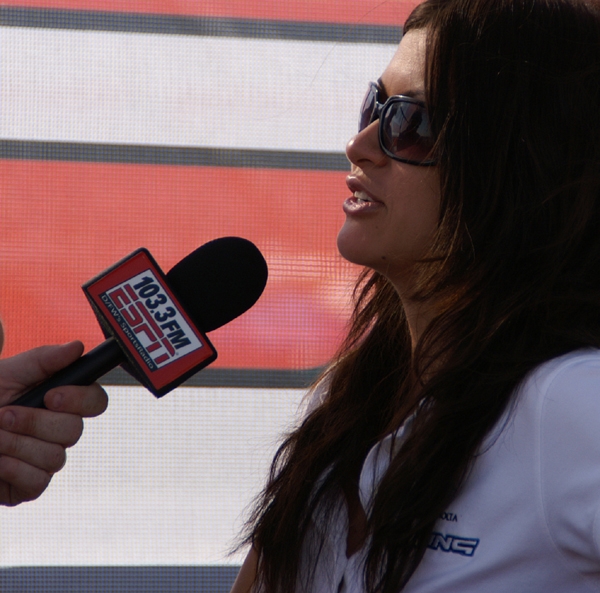
The latest issue of ESPN the Magazine describes me as “an oxymoron: a tree hugging race car driver.” I am an avid environmentalist — I have a degree in biology, I am a former volunteer of a wildlife rehabilitation center and a long time vegetarian. I recently became politically active in environmental legislation; this year I’ve made two trips to Capitol Hill to speak to members of Congress on behalf of the Climate Security Act. The catch? I am also a race car driver. I know, I know… driving 200 mph race cars is by all means a waste of fuel, tires, and carbon fiber. But racing is not just my job – it is my passion and it will always be my first love.
Like it or not, auto racing is the number one spectator sport in America; more people tune in to watch auto races than basketball, baseball and hockey combined. It is the second most popular sport on television, with ratings second only to the NFL. 18 of the top 20 attended sporting events held in the United States are auto races, and while 17 belong to NASCAR, the Indy 500 is the largest attended sporting event in the world with over 400,000 fans gathering annually on the last Sunday in May. With over 75 million of the most brand loyal fans in the world, more Fortune 500 companies sponsor NASCAR than any other sport in the world. What I’m trying to say by all this is, this sport is huge, and though I know this will not make me popular… global warming or not, the sport is not going to go away. I know it is not the most eco friendly sport in the world, and I am on a mission to change that. There are, wrap your mind around this… 100 million race fans in the United States.
So this little tree-hugging race car driver got to thinking, what if I were to start a dialogue with these fans? I started to talk about eco issues on my website several years ago, and I was told by many people in the racing world that I was making a big mistake. They said that as a driver I needed to shut up, drive the car and plug my sponsors. Marketing people warned me that by talking about political and environmental issues I would isolate myself from possible sponsors who would shy away from my “weird, greenie, vegetarian hippie chick image.” (Excuse me; what did you just call me?) Needless to say, I didn’t listen. I decided to talk about what I believed in even if it landed me on the sidelines at the track. I had finally made it to a level in my sport where my races were on TV and I had an audience. I would be a fool to waste that opportunity. So if a sponsor didn’t want to work with me because I promote recycling and caring for the environment, then… thanks, but no thanks, I don’t want you on my race car anyway.
The response was mixed. In between the lovely emails telling me that I was brainwashed by Al Gore (thanks Heartland Institute!), I started to get calls from people who believed in what I was saying. Last year the recycled paper company SMART Papers sponsored my Indy Pro Series car. They told me they had looked at opportunities with various NASCAR and IndyCar drivers and chose me specifically because of my environmental efforts. Likewise, my career as a driver has allowed me to sit with Senators on Capitol Hill to discuss alternative fuels and clean energy. If I wasn’t a race car driver, you probably wouldn’t be reading this article because it is the irony of being a eco-friendly race car driver which gave me the opportunity to write for Huffington Post. So you see, these two seemingly contradictory worlds of mine are endlessly intertwined.
I know some of you are rolling your eyes, calling me a hypocrite, and saying that at the end of the day my race car is still a tire-wasting, fuel-burning polluter. I would not argue with you. So how can I make up for my racing sins? The first thing I do is adopt an acre of rainforest for every race I enter. I know that carbon offsetting is not a solution or a free pass to pollute, but I had to do something about my unavoidable emissions. I also host an eco site where I talk about all the steps I am taking to reduce my carbon footprint. But I know that the place where I can make a real difference is where you would least expect: at the racetrack.
I am in the process of forming what I call my Eco Dream Team. I am going to use my race car as a vehicle (pun intended) to change my sport. Imagine a race car not covered with logos asking fans to buy something but instead calling to action millions of fans to make a difference. Imagine… a black race car, with nothing on it but a CFL lightbulb. Or a canvas grocery bag. Or an aluminum can. Imagine 75 million NASCAR fans recycling their cans. Imagine 40 million IndyCar fans changing their light bulbs to CFLs. Small actions, when multiplied by millions, can make a big difference. Imagine this movement going beyond personal actions. Imagine every race team offsetting their carbon footprint. Imagine every race track with a recycling program. Imagine every racing series using clean renewable alternative fuels. This is my mission. You may think I’m crazy, and maybe I am, but don’t forget what Apple Computers once said. “The people who are crazy enough to think they can change the world, are the ones who do.”
Photo Credit
Craig Davidson




















Introducing She Devil Racing
I was under the thought that Susan (Roush) Mc Clenagahan was compaingi
Sad Day in Motorsports
That's what happens when you let a woman with no interest in racing pr
NASCAR's First Black Woman Driver Talks Race & Racing
And 90% of the official photos she's in are all sexed up. Even when sh
What Type of Male Driver Are You?
As long as a woman gets into the cockpit solely based on merit I don't
F1, No Girls Alowed?
I think the problem is caused by something else. This is F1, this is n